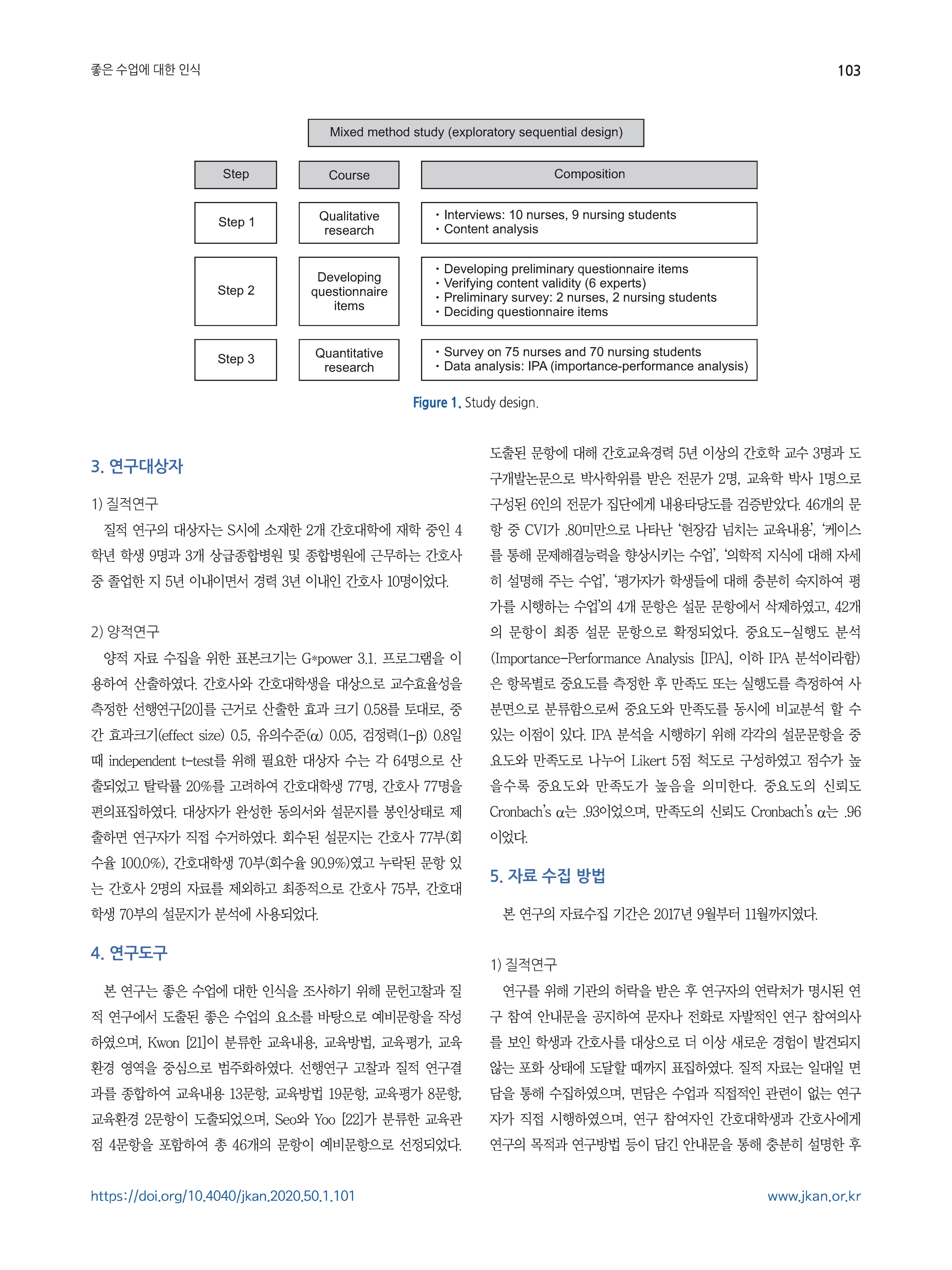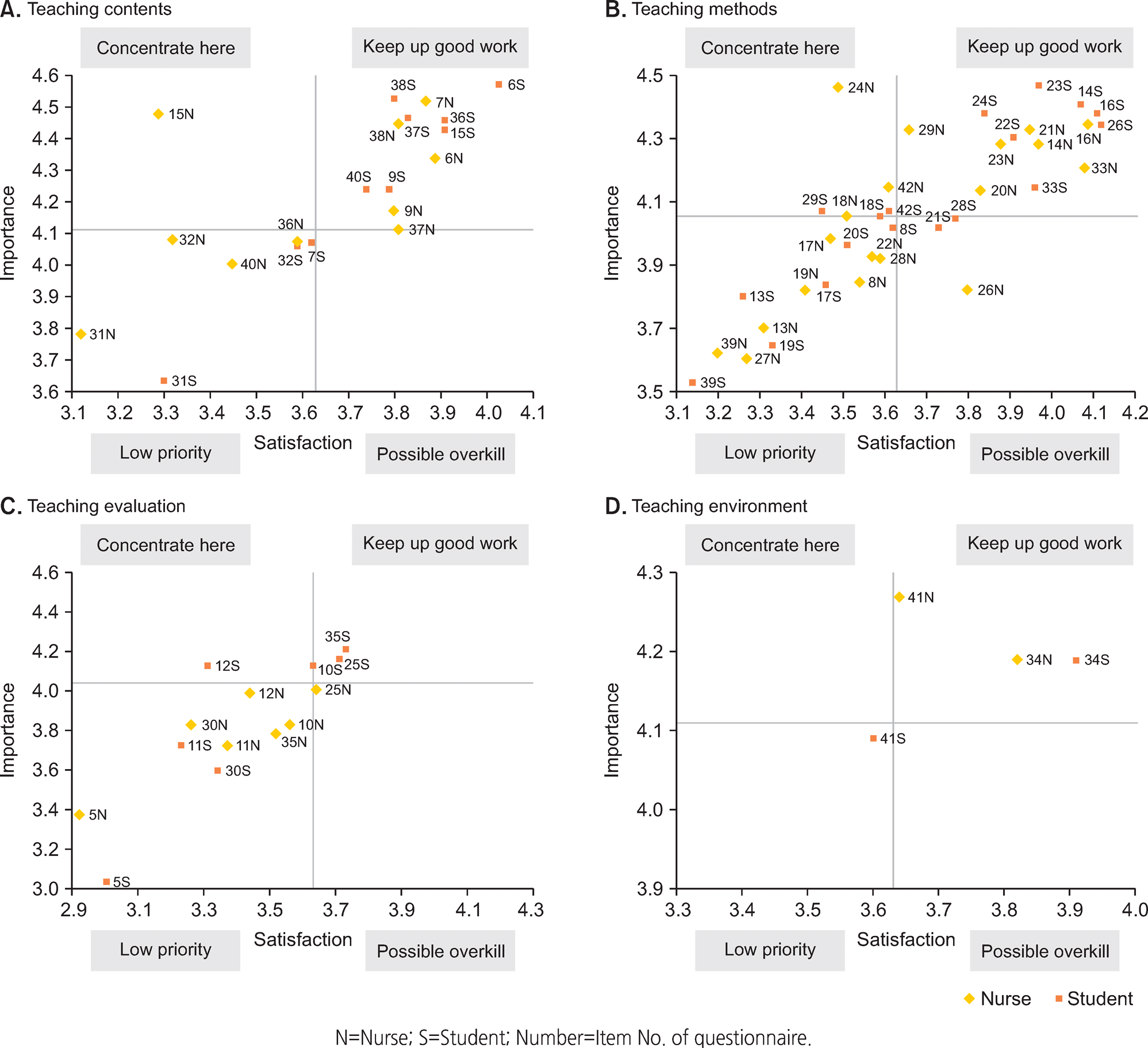Abstract
Purpose:
The purpose of this study was to identify and assess from nursing students and nurses in the clinical field what constitute good instruction, through the review of nursing students’ opinions and clinical field demands.
Methods:
The study design was used Creswell’s exploratory sequential design by collecting and analyzing qualitative data obtained from interviews and then analysis of quantitative data. The participations were 79 seniors in nursing schools and 85 nurses with less than three years of clinical experience. The data were collected through individual interviews and analyzed based on Elo and Kyngäs’s content analysis method. The quantitative data were collected using the questionnaire developed based on qualitative results and analyzed by SPSS 23.0 program and Importance Performance Analysis (IPA).
Results:
The results showed that IPA extracted seven items with high importance but low satisfaction: “nursing fads and trends,” “teacher-learner communication and reflection,” “materials used in clinical settings such as monitoring results and test results,” “special presentations by experienced practitioners,” “instruction assures learners’ comprehension,” “accurate and detailed evaluation standards” and “feedback on homework and exam.”
Conclusion
The factors comprising good instruction were verified, and the necessity for additional efforts to improve high importance and low performance factors was noted. Therefore, this study can serve as a guide for nursing education facilities and educators in developing of a thorough education system with excellent instruction designed to achieve an ideal nursing education.
Go to : 
REFERENCES
1. Pagnucci, N, Carnevale, FA, Bagnasco, A, Tolotti, A, Cadorin, L, Sasso, L. A cross-sectional study of pedagogical strategies in nursing education: Opportunities and constraints toward using effective pedagogy. BMC Medical Education. 2015; 15:138. https://doi.org/10.1186/s12909-015-0411-5.

2. Committee on The Robert Wood Johnson Foundation Initiative; Institute of Medicine. Future of nursing: Leading change, advancing health. Washington D.C.: National Academies Press;2010. p. 1–700.
3. Kim JA, Chu MS, Kwon KJ, Seo HK, Lee SN. Core competencies for new nurses. Journal of Korean Clinical Nursing Research. 2017; 23(1):40–53. https://doi.org/10.22650/JKCNR.2017.23.1.40.
4. Numminen O, Laine T, Isoaho H, Hupli M, Leino-Kilpi H, Meretoja R. Do educational outcomes correspond with the requirements of nursing practice: Edu cators’ and managers’ assessments of novice nurses’ professional competence. Scandinavian Journal of Caring Sciences. 2014; 28(4):812–821.
5. Sin KM, Kim EY. A concept analysis on reality shock in newly graduated nurses using the hybrid model. Korean Journal of Occupational Health Nursing. 2017; 26(1):19–29. https://doi.org/10.5807/kjohn.2017.26.1.19.

6. Kumaran S, Carney M. Role transition from student nurse to staff nurse: Facilitating the transition period. Nurse Education in Practice. 2014; 14(6):605–611. https://doi.org/10.1016/j.nepr.2014.06.002.

7. Kajander-Unkuri S, Meretoja R, Katajisto J, Saarikoski M, Salminen L, Suhonen R, et al. Self-assessed level of competence of graduating nursing students and factors related to it. Nurse Education Today. 2014; 34(5):795–801. https://doi.org/10.1016/j.nedt.2013.08.009.

8. Scully NJ. The theory-practice gap and skill acquisition: An issue for nursing education. Collegian. 2011; 18(2):93–98. https://doi.org/10.1016/j.colegn.2010.04.002.

9. Yune SJ, Lee YN, Lee SS. An analysis of undergraduate student essays on good instruction. The Journal of Korean Education. 2009; 36(4):125–149.
10. Alves PF. Vygotsky and Piaget: Scientific concepts. Psychology in Russia: State of the Art. 2014; 7(3):24–34. https://doi.org/10.11621/pir.2014.0303.

11. Schunk DH. Learning theories: An educational perspective. Noh SJ, Choi BY, Cha HJ, Jang KW, Oh JE, So HJ, translators. Paju: Academypress;2016. p. 1–686.
12. Choi SH. Analysis on the characteristics of good teaching perceived by junior college student: Based on a case study of K college. The Journal of the Korea Contents Association. 2014; 14(8):517–527. https://doi.org/10.5392/JKCA.2014.14.08.517.
13. Waltz CF, Jenkins LS, Han N. The use and effectiveness of active learning methods in nursing and health professions education: A literature review. Nursing Education Perspectives. 2014; 35(6):392–400. https://doi.org/10.5480/13-1168.

14. Kim YM, Park H. Current trends of teaching-learning methods in Korean undergraduate nursing education. Journal of Learner-Centered Curriculum and Instruction. 2016; 16(3):945–966.
15. Berman AC. Good teaching is good teaching: A narrative review for effective medical educators. Anatomical Sciences Education. 2015; 8(4):386–394. https://doi.org/10.1002/ase.1535.

16. Johnson-Farmer B, Frenn M. Teaching excellence: What great teachers teach us. Journal of Professional Nursing. 2009; 25(5):267–272. https://doi.org/10.1016/j.profnurs.2009.01.020.

17. Stronge JH. Effective teachers=student achievement: What the research says. New York: Routledge;2013. p. 1–192.
18. Park KJ, Ryu CR, Choi J, Jung HC. An analysis on the science gifted education recipients’ perception for education program using an importance-performance analysis. Journal of Gifted/ Talented Education. 2016; 26(3):427–447. https://doi.org/10.9722/JGTE.2016.26.3.427.

19. Creswell JW. Research design. 4th ed. Thousand Oaks (CA): SAGE Publications;2014. p. 1–273.
20. Yu PS, Kim ES, Kim HK, Lee SH, Hyoung HK, Eom AY, et al. The perception degree of teaching effectiveness of nurses and nursing students on clinical nursing practicum. Journal of Korean Academy of Nursing Administration. 2008; 14(3):311–320.
21. Kwon SY. Teachers’ conceptions of good teaching in secondary school: The analysis of importance and performance. Journal of Educational Technology. 2010; 26(1):185–215.
22. Seo KH, Yoo SY. The good instructional practice from teachers’, students’ and parents’ perspectives. Korean Journal of Educational Research. 2004; 42(4):285–315.
23. Elo S, Kyngäs H. The qualitative content analysis process. Journal of Advanced Nursing. 2008; 62(1):107–115. https://doi.org/10.1111/j.1365-2648.2007.04569.x.

24. Good TL, Brophy JE. Looking in classrooms. 10th ed. Boston (MA): Pearson Education;2008. p. 1–528.

25. Ahn JH. A qualitative study on characteristics of “good” college classes in the humanities and social sciences courses [dissertation]. Seoul: Yonsei University;2012. p. 1–210.
26. Choi SH, Ahn HJ. Investigating the requirements of good teaching from medical students’ perspectives. Korean Medical Education Review. 2016; 18(3):156–166. https://doi.org/10.17496/kmer.2016.18.3.156.

27. Hwang JI, Yoon TY, Jin HJ, Park Y, Park JY, Lee BJ. Patient safety competence for final-year health professional students: Perceptions of effectiveness of an interprofessional education course. Journal of Interprofessional Care. 2016; 30(6):732–738. https://doi.org/10.1080/13561820.2016.1218446.

28. Shakman L, Renu G, Obeidat A. Inter professional education in health care. International Journal of Nursing Education. 2013; 5(1):86–91. https://doi.org/10.5958/j.0974-9357.5.1.021.

29. Kim KH, Hwang E, Shin S. Current status and future direction of interprofessional education in nursing education. Korean Medical Education Review. 2017; 19(1):18–24.

30. Kwon YS. An analysis of factors of effective lecturing behaviors in university class [dissertation]. Seoul: Yonsei University;2006. p. 1–176.
31. Tomlinson CA, McTighe J. Integrating differentiated instruction & understanding by design: Connecting content and kids. Kim GJ, On JD, Jang SB, translators. Seoul: Hakjisa;2013. p. 1–298.
Go to : 
Table 1.
General Characteristics of Participants in Quantitative Survey (N=145)
Table 2.
Differences between Nursing Students and Nurses in Recognition of Good Instruction (N=145)




 PDF
PDF ePub
ePub Citation
Citation Print
Print




 XML Download
XML Download